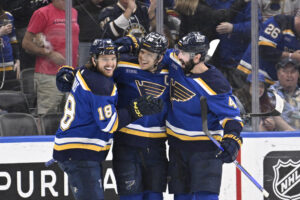Player development seems to always result in more questions than answers. How likely is it for a top pick to pan out? What makes a player a “steal”? Last Word On Hockey will be starting a new series on how to properly develop prospects from all different spots throughout the draft. This week’s piece involves top-15 picks and how they were used early in their careers.
NHL Player Developments Of Top-15 Picks
In the span of 2005 through 2015, there were 21 total selections made between 11th overall and 15th overall on forwards playing in North America. Looking at all 21 forwards, they were split into different categories. Today, we’ll look at the category of “Rushed slightly”. That category had three players. Those players were Jake DeBrusk, Zack Kassian, and Zach Boychuk. In this piece, we will look at DeBrusk and Kassian.
Development Of Jake DeBrusk
DeBrusk, who was part of the infamous Boston Bruins draft class of 2015, was taken 14th overall, coming out of WHL’s Swift Current Broncos. In his DY-1 season, he played 72 games with 15 goals and 24 assists for 39 points. That was good for 0.542 points per game, ranking 12th out of 21 forwards. The following season, he played another 72 games, this time scoring 42 goals and 39 assists for 81 points. That was good for 1.125 points per game, ranking ninth out of 21 forwards, this time for draft year production. After being selected by the Bruins, DeBrusk would return to the WHL for one more season.
In his DY+1 season, DeBrusk would score nine goals and 17 assists for 26 points in 24 games with the Broncos before being dealt to the Red Deer Rebels. He would then score 12 goals and 27 assists for 39 points in 37 games. In total, he scored 65 points in 61 games for 1.066 points per game. That ranked 13th out of 20 forwards still outside the NHL in DY+1 production. Following that season, he would play in the AHL. He scored 19 goals and 30 assists for 49 points in 74 games for 0.662 points per game. That ranked 10th out of 12 forwards still outside the NHL in DY+2 production. After a full AHL season, he would get his NHL shot.
How Was DeBrusk Used?
In his first season at the NHL level, he would play 70 games, scoring 16 goals and 27 assists for 43 points while averaging 14:22 time on ice per game. Analytically, DeBrusk was fantastic. His even-strength offence goals above replacement (EVO) showed a high level of impact, with a score of 11.3. That is the second-best EVO recorded by the 21 forwards looked at. As for his even-strength defence goals above replacement (EVD), he left a lot to be desired with a score of -2.7. But, his great EVO led his wins above replacement (WAR) and goals above replacement (GAR) to be outstanding for a rookie, at 2.3 and 12.0, respectively.
In his second NHL season, he would play 68 games, scoring 27 goals and 15 assists for 42 points, while averaging 16:10 time on ice per game. While his goal-scoring improved, his playmaking took a hit. That led to his EVO taking a hit (6.3). However, he had an exponential improvement in his EVD (3.4). So, despite the dip in offensive impact, his improvement in defence led his WAR (1.5) and GAR (8.2) to still be solid.
DeBrusk Takes A Big Step Back In Year Three
In his third season, DeBrusk would play 65 games, where he would record 19 goals and 16 assists for 35 points while averaging 16:03 time on ice per game. His continued decline in overall offensive impact, plus a slide back in goal-scoring, led his analytics to see a rapid decline. His EVO (0.1) and EVD (1.5) were barely above replacement, and both saw declines. That led to his WAR (-0.1) and GAR (-0.3) to fall below replacement level.
After that third NHL season, DeBrusk would see another poor year, and then a bounce back the year after. In total, since that third season, DeBrusk played 118 games, with 30 goals and 26 assists for 56 points. Overall, the Bruins player development of DeBrusk was fine. He was given a solid rookie year role and impressed in a big way. Then, he was given a raise after a big improvement defensively, as he should have. But, he struggled mightily in his second season, despite maintaining a very similar role that year. Then the following season, he struggled massively. The Bruins really didn’t do anything poor with his development, DeBrusk just could not continue his rookie year dominance that he displayed.
Development Of Zack Kassian
Zack Kassian, who was drafted 13th overall by the Buffalo Sabres in the 2009 NHL entry draft, came out of the OHL’s Peterborough Petes organization. In his DY-1 season with the Petes, Kassian scored nine goals and 12 assists for 21 points in 58 games. That was good enough for 0.362 points per game, ranking 19th out of 21 forwards in DY-1 production. The following season, Kassian would post 24 goals and 39 assists for 63 points in 61 games played, for 1.033 points per game. That ranked 12th out of 21 forwards in DY production. Despite a big jump in production and being drafted top-15, Kassian would return to the OHL for two more seasons.
In his DY+1 season, Kassian scored eight goals and 19 assists for 27 points in 33 games with the Petes before being dealt to the Windsor Spitfires. With Windsor, he would play five games, scoring four goals. In total, Kassian scored 12 goals and 19 assists for 31 points in 38 games, for 0.816 points per game. That ranked 14th out of 20 forwards still outside the NHL in DY+1 production. In his final OHL season, DY+2 for Kassian, he would score 26 goals and 51 assists for 77 points in 56 games with the Spitfires. That was good for 1.375 points per game, ranking second out of 12 forwards still outside the NHL in DY+2 production.
How Was Kassian Used?
In his first NHL season, Kassian would split between the Sabres and their AHL affiliates, Rochester Americans, before being traded to the Vancouver Canucks. Overall, Kassian would play 44 NHL games and 30 AHL games. In the AHL, he scored 15 goals and 11 assists for 26 points. At the NHL level, he scored four goals and six assists for 10 points, while averaging 11:18 time on ice per game. Analytically, Kassian was not great. His EVO was the only stat above replacement value (0.3), and only barely. His EVD was below replacement level (-0.7). That led to his WAR (-0.1) and GAR (-0.6) to also drop below replacement level.
In his second season, this time with Vancouver, he would again split between the Canucks and their AHL affiliate, Chicago Wolves. In the AHL, he would score eight goals and 13 assists for 21 points in 29 games. Meanwhile, he would play 39 NHL games, scoring seven goals and four assists for 11 points, while averaging 13:29 time on ice per game. In this expanded role in ice time, Kassian’s EVO improved slightly (0.4). However, his EVD was abysmal (-5.0). That led to his WAR (-0.8) and GAR (-4.1) to fall even more than the year prior.
Big Player Development Season Ahead For Kassian
Despite the poor performance in his second season, his Canucks coaches instilled faith in their big, young forward. That was reflected in playing 73 NHL games, without being relegated to the AHL level. He would score 14 goals and 15 assists for 29 points while playing an average of 12:56 time on ice per game. His EVO was incredibly improved (7.8), which reflected his offensive output improving in his third season. Meanwhile, his EVD also improved, though it still wasn’t great (-0.1). However, with that impressive improvement, Kassian’s WAR (1.1) and GAR (5.7) both became really strong totals.
Following that third NHL season, he would play one more season with the Canucks, scoring 10 goals and six assists for 16 points in 42 games. After that season, Kassian would join the Edmonton Oilers, where he still plays today. Since joining, he has played seven seasons, scoring 55 goals and 80 assists for 135 points in 412 games played. Kassian never became a top player at the NHL level, like the Sabres drafted him to be. However, his player development path never set him up for that opportunity. He was given limited ice time in just about every season in his career. Only once surpassing an average of 15 minutes of ice time per game. But he did develop into a serviceable forward.
Junior league stats via Elite Prospects, NHL stats via Hockey Reference, NHL analytics via Evolving Hockey
Main photo:
Embed from Getty Images






